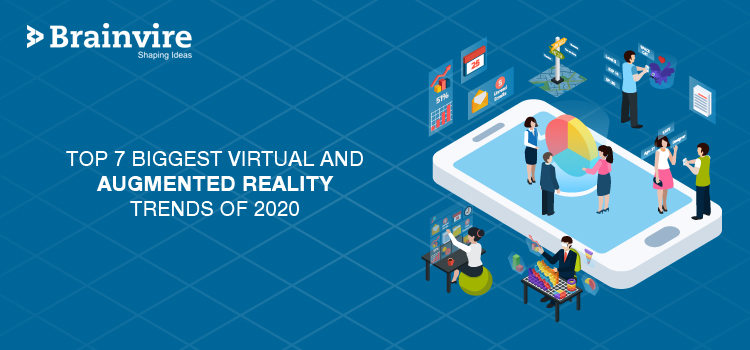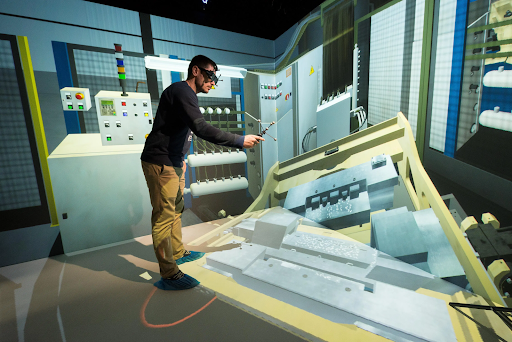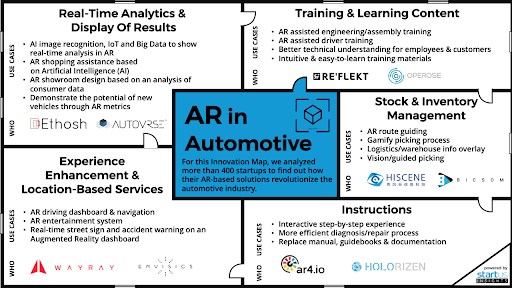2019 took virtual and augmented reality (VR/AR) - known collectively as extended reality (XR) - to a new level and raised its expectations in the eyes of users. The presence of these breakthrough technologies was felt in domains other than gaming and entertainment. Education, defense, healthcare, and e-sports are some of them.

Here are some stats to prove the growth of AR and VR -
- The market value of virtual reality was USD 7.90 billion in 2018 and is expected to cross USD 34.08 billion by 2023. The CAGR is expected to be around 33.95% during the forecast period.
- The revenue generated by the Augmented Reality market is expected to hit $70-$75 billion by 2023.
- 70-75% of people aged 16-44 have basic knowledge about the potential of AR.
- Microsoft has sold over 50,000 units of its first-generation AR glasses, HoloLens. It's priced at a whopping $3500 for commercial users.
(Source: Vxchnge)
As you can see, the potential of AR development and virtual reality is huge. Check out some of the popular trends ruling these technologies in 2020.
Top Trends in AR and VR
- XR takes a front seat in healthcare
- Headsets get smaller, mobile, and more powerful
- AR investments in the defense sector will grow
- VR CAVE comes into the limelight
- VR and AR will become more collaborative and social
- Automotive manufacturers will improve safety using AR
- Artificial Intelligence will further enhance AR and VR
Here's more information on them.
#1 XR takes a front seat in healthcare
In 2020, we can expect the transition of many XR use-cases from trials to general use.
Virtual reality is used in therapy to treat patients with phobias and anxiety disorders. Therapists can use biosensors to monitor physiological reactions like heart rate and perspiration and get a better understanding of how patients react to stressful situations.
VR also helps people with autism develop their social and communication skills, as well as diagnoses visual or cognitive impairments in patients by tracking their eye movement.
The adoption of AR in healthcare will grow and the market value will increase by 38% annually by 2025. Surgeons can use AR both in the theater and in training to identify different types of risks or hazards.

Image credit: Analytics Insight
There are other applications of augmented reality development in healthcare. For example, AED4EU helps users get the closest automated external defibrillators (AEDs) to treat patients for sudden cardiac arrest as soon as possible. The app provides the nearest location of AED and also the phone number and address.
#2 Headsets get smaller, mobile, and more powerful
Every piece of technology has its own limiting factors. In the current XR technology, there is a need for encumbering headsets and display units. This becomes a bigger problem with VR, where the powerful processing hardware is usually contained within the headset.
However, hardware devices are now becoming "untethered." For example, Facebook's Oculus headset had to be initially connected to a powerful PC. But this year, they became available as a self-contained Oculus Quest version.
Headsets will also be fitted with more powerful processors. The early VR worlds were computer-generated using low-resolution polygons, but the vistas available to us in 2020 will offer more immersive experiences.
| Apple's 8K VR/AR Glasses: MOST ANTICIPATED BREAKTHROUGH
These glasses will not be tethered to a computer or phone. The consumer tech giant hopes to break XR into the mainstream with a high-end but affordable device as it did with the iPhone. |
#3 AR investments in the defense sector will grow
Better technology helps defense forces offer their recruits unparalleled training. Different battlefield situations can be replicated virtually similar to Call of Duty and other first-person shooter games.
Governments of developed (and even developing) nations are investing heavily in cutting-edge technology. The US military has experimented with different facets of augmented reality development for several years to deliver actionable data to personnel without overloading them with choices. One of the most noteworthy successes in this regard is the F-35 fighter jet's $400,000 helmet. It not only allows the pilot to look through the plane but also identifies and provides information about any object in the pilot's field of view.
#4 VR CAVE comes into the limelight

Image credit: Antycip Simulation
CAVE (Cave Automatic Virtual Environment) is one of the key advancements in the VR world. It is a small room or cubicle with at least three or more walls acting as large display monitors. The immersive displays give the user a very wide field of view. Most head-mounted displays (HMDs) can't do this. Users can also move around in the CAVE system, which works without being tethered to a computer.Â
#5 VR and AR will become more collaborative and social
In 2020, AR and VR headsets will help family and friends interact through virtual reality. WeChat is an excellent example of this integration and incorporates VR into the mobile messaging system. Additionally, Facebook's VR Spaces platform allows individuals to meet and socialize in this environment.
Currently, trends are indicative of AR tools for offices and boardrooms that allow people to see and engage with pinboards, virtual whiteboards, and even overlay real-world objects with designs.
#6 Automotive manufacturers will improve safety using AR
Incorporating AR in automobiles improves safety which is affected by the use of Sat-nav and phone screens. AR devices in vehicles provide the driver with crucial information. This technology is used in NVIDIA's Drive AR platform. It uses a dashboard-type of display that overlays graphics from around the car. The information provided depicts useful details including potential threats or historical landmarks found along the way.Â
WayRay uses AR technology to directly project lane identification, navigational directions, and hazard detection on a driver's windshield.
Besides these applications, there are other important use-cases of AR development in the automotive industry. They are -
- AR instructions and guides can replace long and complex manuals.
- AR headsets will automate the training process in the manufacturing or maintenance of automobiles.
- AR route guide.
The image below provides a comprehensive overview of the different uses of AR in this industry.

Image credit: Startus Insights
We are not surprised that the total augmented reality automotive market is growing at an annual rate of 177% and will reach $5.5 billion by 2022.
#7 Artificial Intelligence will further enhance AR and VR
AI technology, such as computer vision, allows computers to comprehend and label objects seen through a camera. It helps in identifying and labeling the user's field of view.
A perfect example of AI enhancing AR technology is the filters used on Snapchat or Instagram such as the cat whiskers. Another groundbreaking integration of AI and AR is the machine learning-enabled microscope. It can detect and highlight cancerous tumor growth while a pathologist is examining the samples through a viewfinder.
When we talk about VR, the virtual environments and its components will turn more intellectual. The adoption of voice control will gain prominence moving forward and will significantly decrease the use of icons and menus in a virtual environment. For example, in video games, computer-controlled players can react and adapt to a person's playing style quickly.
A Final Word
The future is bright for AR and VR. Understand how these technologies can make a difference to your business. Get in touch with a company specializing in AR development to get started immediately.